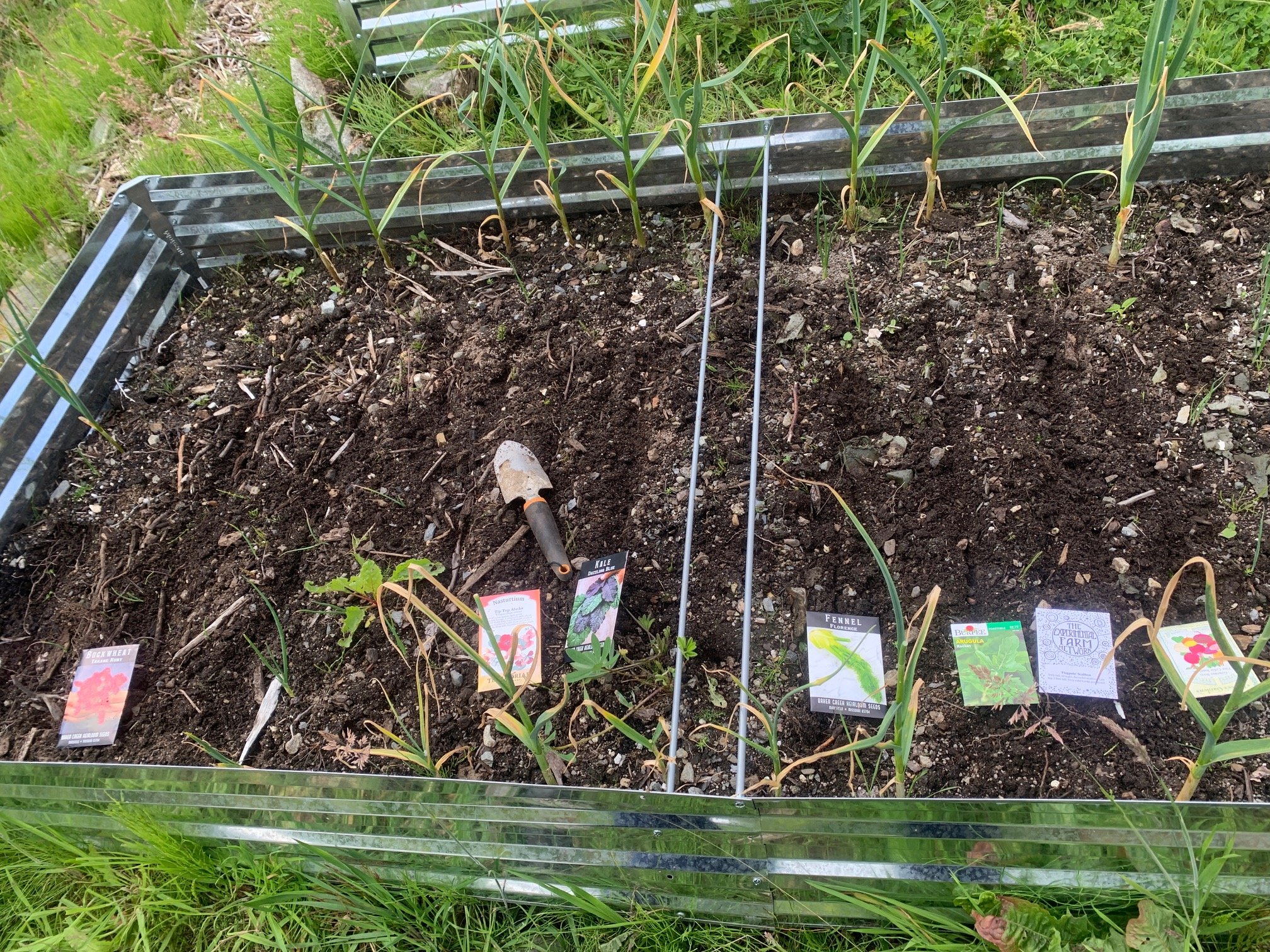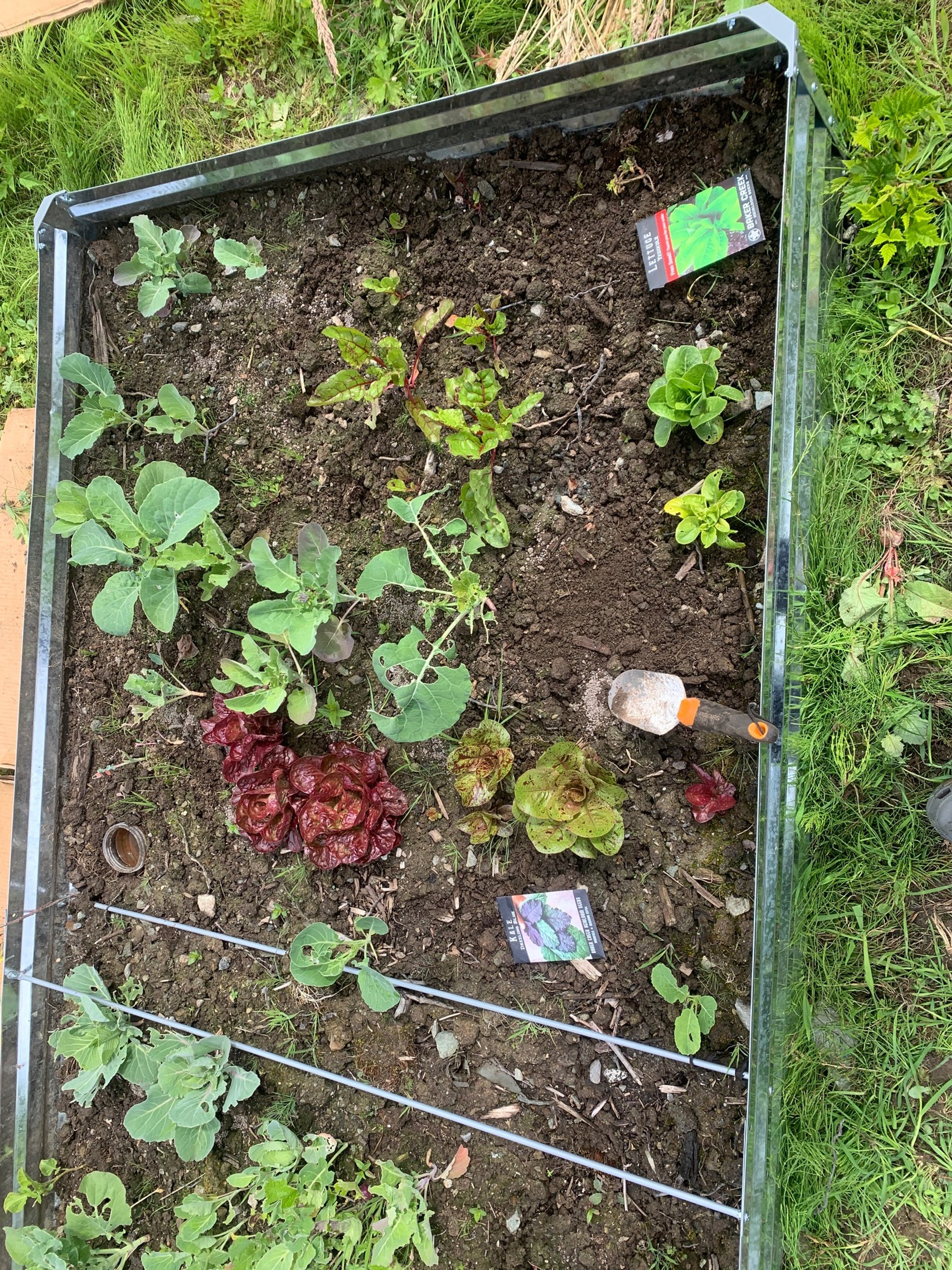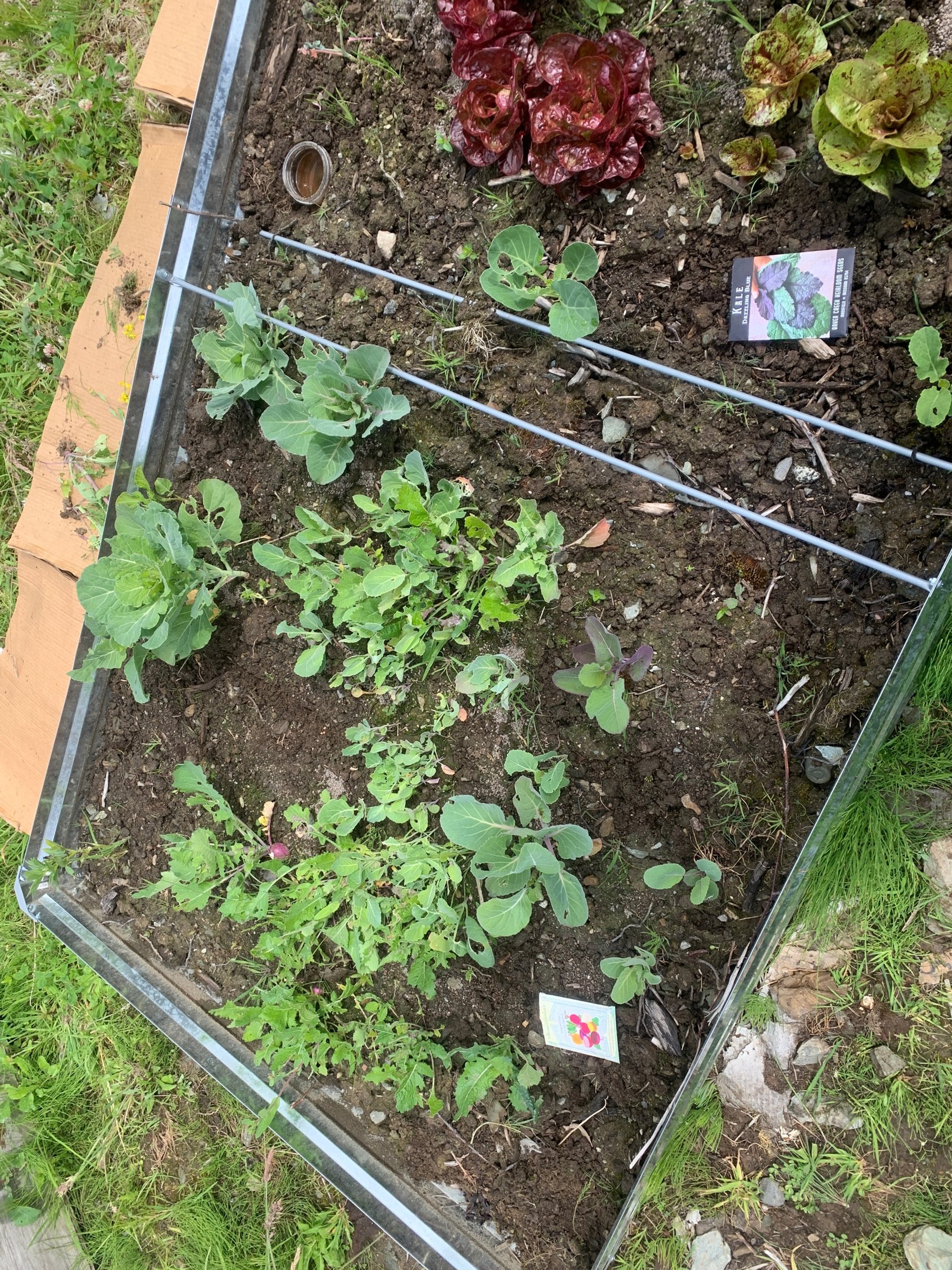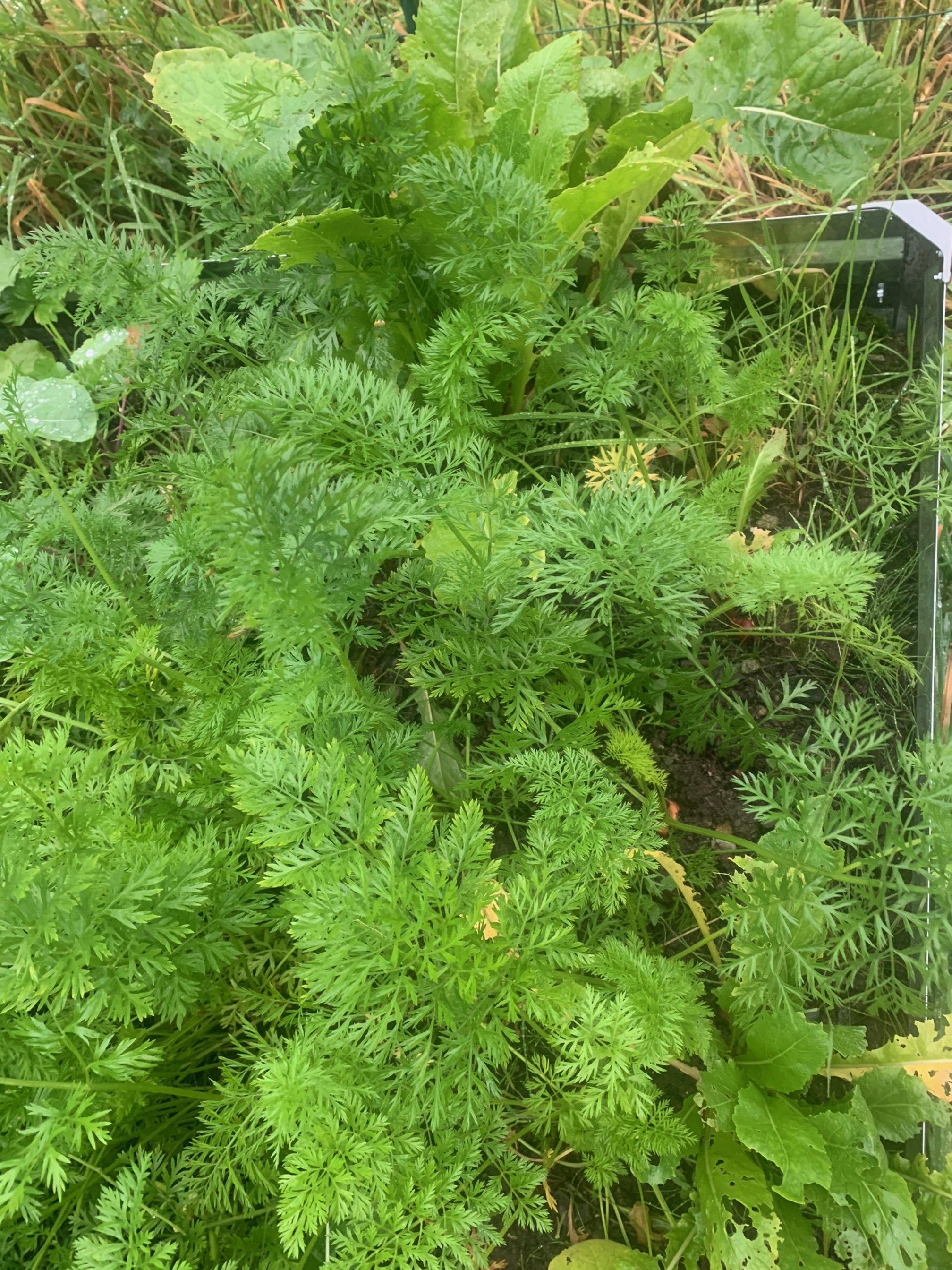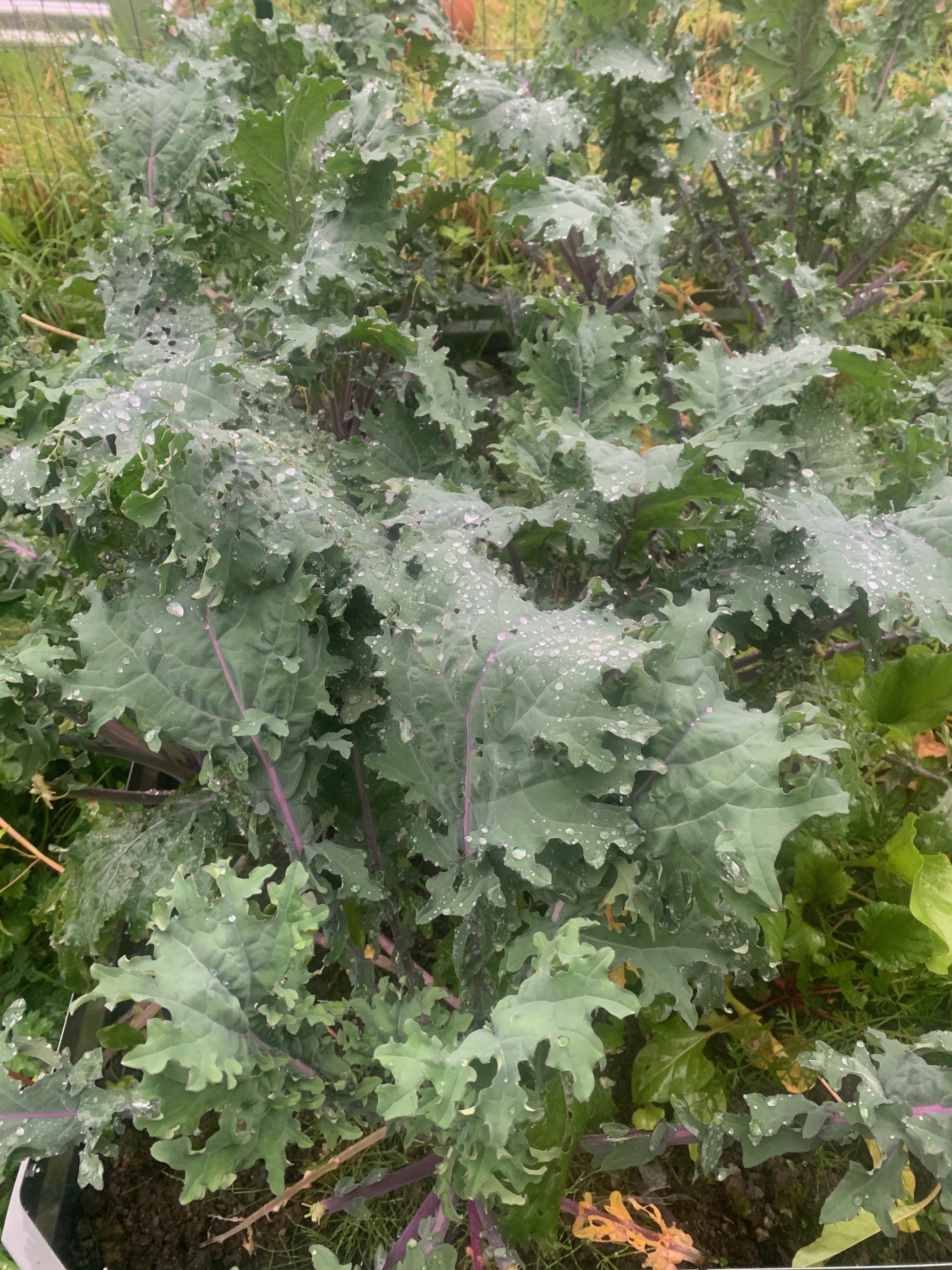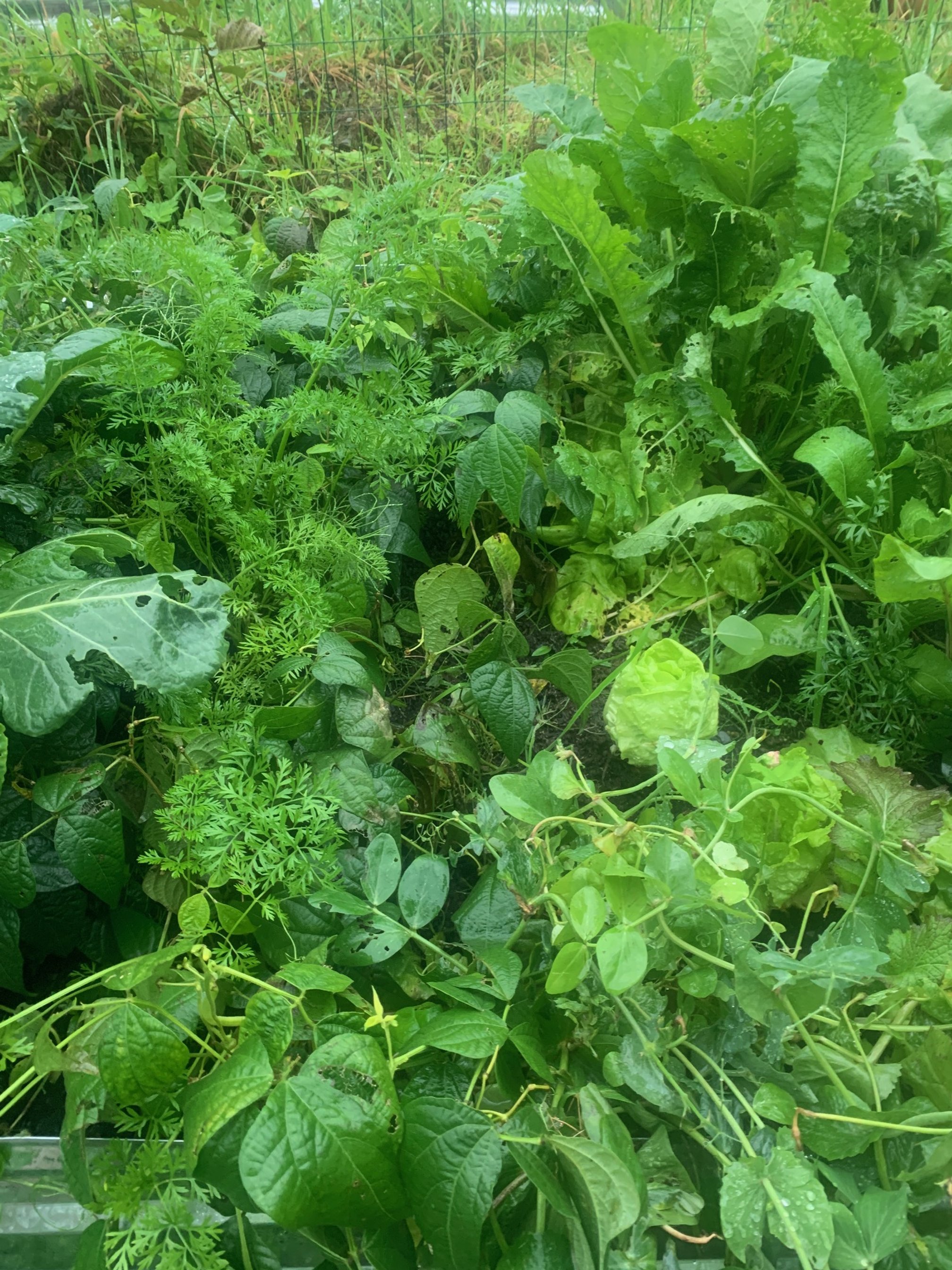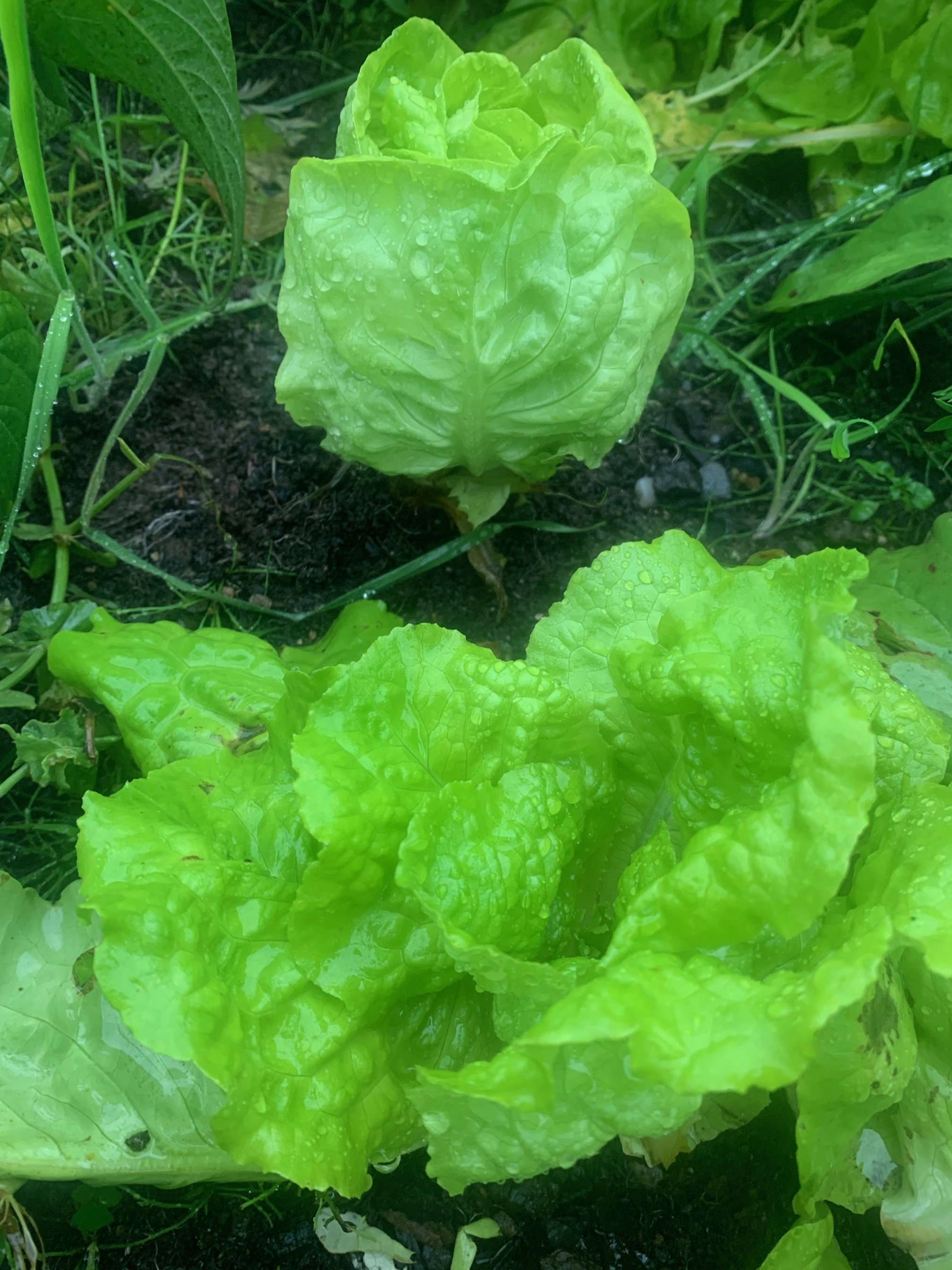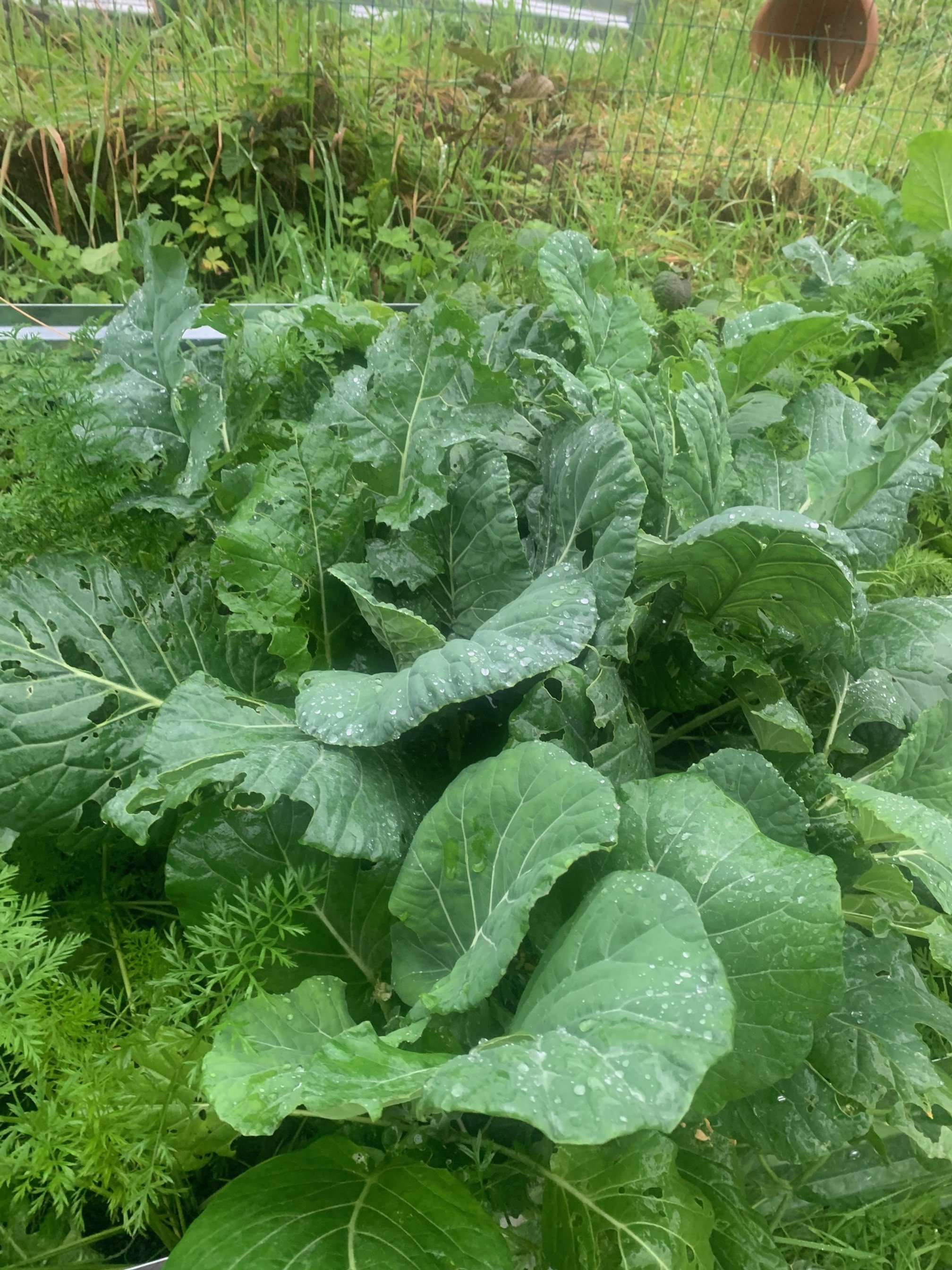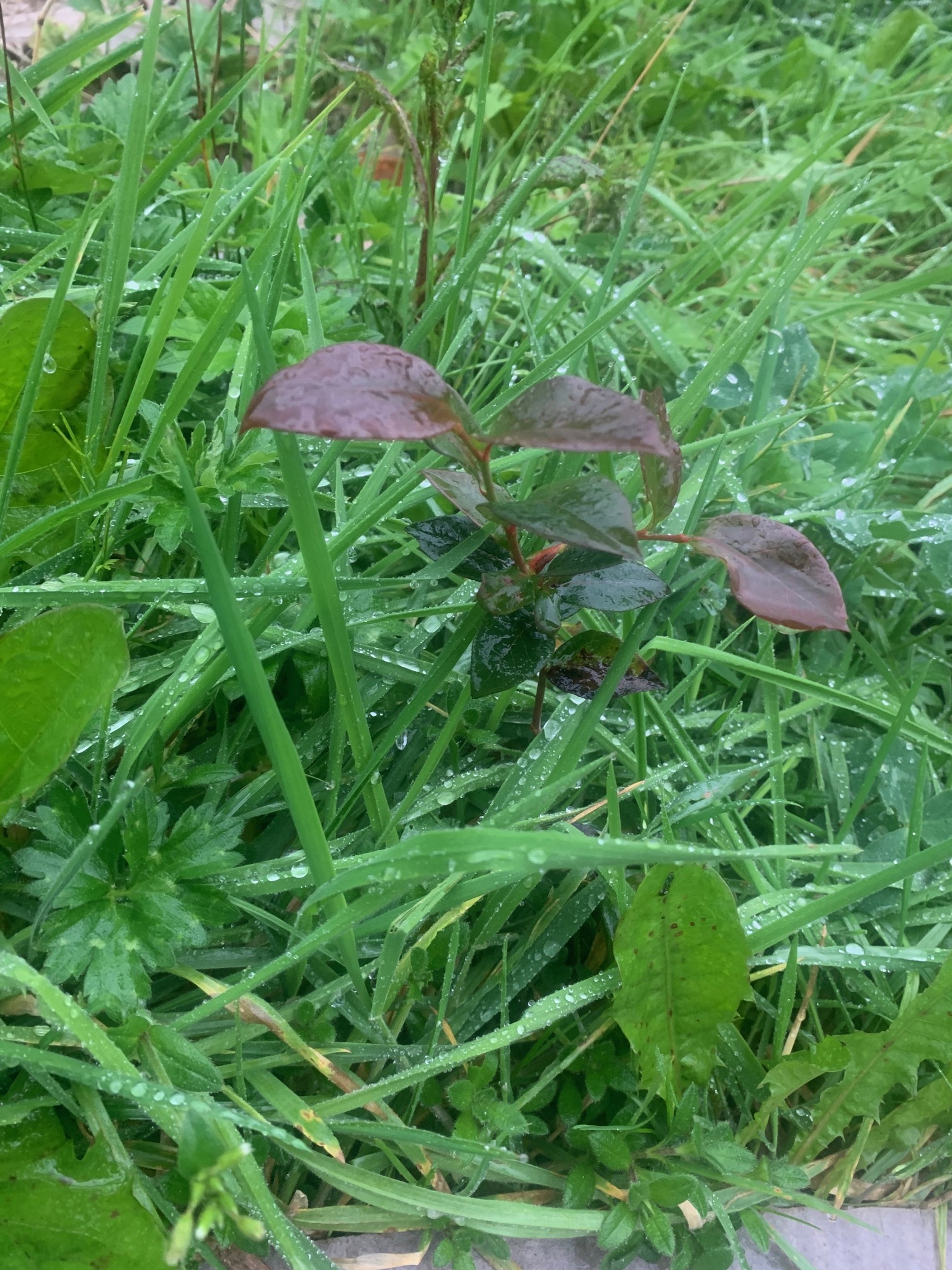Gardening in Southeast Alaska: Season Review
Garden Overview
Garden on August 23, 2023.
2022 Garden overview 2024 Garden recap
Successes
Lots of greens, beans, carrots, potatoes and garlic! We’ve been eating vegetables almost exclusively from the garden for about 2 months now. I’m hoping to stretch it through October. I didn’t grow much surplus to store or can but hoping to improve on yields next year now that I have a better idea of what works.
I have also harvested some tomatoes, zucchini and expect to harvest some spaghetti squash, but there were some challenges with these that I’ll discuss below.
I also established cherry trees, gooseberries, blueberries, strawberries and honeyberries that I hope to harvest next year.
Garden beans, carrots and beets on August 21, 2023.
Challenges
1. Slugs
Slugs are a constant battle in the garden in Southeast Alaska. Especially early in spring, they will eat entire seedlings. I tried beer traps, which are effective but you need a lot of them to keep the slugs off your plants and you have to refresh the beer every couple of days because it evaporates when it's warm and gets diluted when it rains.
Instead, I ended up picking slugs off plants in the mornings. When I started, I averaged 30+ slugs the first 5 days, but after that, it went way down. I mostly stopped picking slugs after June and had some slug damage on plants but they were well established enough that it was a small loss. I also did a couple isolated days of slug killing in August and September when the slug damage seemed like it was increasing.
There are also commercial slug killers you can buy that I’ve heard are effective, but they kill all insects and I’m trying to minimize chemical use in the garden, so I don’t use it.
Next year, I’m going to try to stay on top of the weeds in the yard more. My garden beds are raised 1 foot, but the surrounding area is full of weeds - European grasses, clover, sow thistle, hawkweed, dandelion, etc., which is a haven for slugs. I think it i kept the yard tidier, it would eliminate some of the hiding places for slugs
2. Pollination
The apple trees and squashes are my two main crops that require pollination. Neither was well pollinated this year. My three apple trees set a total of 9 apples. Zucchini and spaghetti squash did ok when I hand pollinated them. Additionally, slugs loooove to eat the flowers off my squash, which prevents pollination.
My hope is that if I plant more and earlier blooming flowers I can attract more pollinators to the garden. I’ll also try to stay up on slug control and hand pollination. I’ll also be on the lookout for self fertile (parthenocarpic) squashes/cucumbers.
Zucchini flower damaged by slugs.
3.Weeds
Our lot was a gravel pad not too long ago (finished building our house February 2023), so the conditions aren’t great for native plants. Weeds really thrive though. They grew up around all the little fruit bushes I planted, in some cases covering and out competing them completely. They also grow in all my raised beds. Horse tail is especially tenacious.
Densely planted beds helped to shade out weeds, but I had to do a fair bit of weed pulling. Towards the middle of the summer I realized weeds would grow in any gaps, so I started planting buckwheat in the gaps for soil improvement and to shade out weeds. I’ve also started to fight the weeds in the yard around my raised beds to eliminate the seed source. I’ve put cardboard down in between beds to block weeds. The cardboard breaks down relatively quickly in Ketchikan rain though and I have weeds growing in breaks in the cardboard now. I might put down a weed barrier and then cover it with gravel. I’d like to have a more natural yard, and some of the invasives, like clover, are good for pollinators, but it's an overwhelming amount of weeds.
4. Birds
In spring, migratory birds will eat seedlings and seeds of all kinds, especially beans/peas. Ideally these crops are covered through early June. I learned this last year, but didn’t think about it when hardening off seedlings to transplant outside. I had started a bunch of tomatoes, cucumbers, squashes etc., but when hardening them off on my porch an animal (I think maybe a crow or raven, but could have been anything) got into them and destroyed them
2023 Garden Details
This year I put in 6 raised beds and added two cherry trees, several blueberry, honeyberry and gooseberry bushes, and raspberry canes. That’s in addition to 3 apple trees from last year. I focused on growing crops that typically do well in the cool wet climate, including greens of all kinds (lettuce, spinach, kale, collards, arugula), beets, carrots, garlic, leeks, broccoli, cabbage, peas, potatoes, zucchini, herbs and flowers. It's easy to get overwhelmed and discouraged, so I decided to start with things I expected to be easier to grow.
Garden on September 26, 2023.
1. Vegetables
This section outlines each crop I grew, varieties, planting notes, how they did, if I’ll plant again and what I’d do differently. Crops are loosely ordered from more productive to less productive.
I tried out a lot of different seeds this year to try to get an idea for what grows well here.
Kale: Red Russian planted May 13, Dazzling blue planted July 1. We have been harvesting Kale for salads since mid July. The Red Russian produces abundantly. The Dazzling blue seems to grow more slowly and has more slug damage. We love the Red Russian variety but it is nice to have some variety so will likely plant both again next year.
Dazzling blue kale surrounded by nasturtiums, as well as some fennel, onions, and turnips on September 26, 2023.
Collards: Georgia Southern planted May 13. Began harvesting in mid July. I wasn’t sure how well this would produce because the variety has “Southern” in the name and collards like heat, but we have been alternating sauteed collards and kale salad for our veggies for most of August and September. Will plant again!
Carrots: Northern lights carrot blend (Territorial seeds) planted April 19 and May 28. Smaller carrots were ready to harvest mid July but kept growing bigger throughout the summer. I was very happy with the germination and growth of all the carrots in this variety - orange, yellow, white and purple. Will definitely plant again next year.
Lettuce: little gem, trout back, merveille des quatre saisons planted April 19. Gustav’s salad planted July 1. Started harvesting outer leaves of early lettuce July 10. I like all these lettuces and they grow well. Little gem bolts quickest for me and produces small heads. Trout back and merveille des quatre saisons hold relatively well, but merveille des quatre saisons seems to be more productive. Gustav’s salad was ready for harvest late August and has held well in the cool, rainy climate. Next year I’ll go all in on merveille des quatre saisons and Gustav and do more successional planting.
Merveille des quatre saisons lettuce on July 10.
Garlic: Music and Russian red planted in October. Started harvesting a few bulbs for use July 1 and pulled all remaining bulbs July 15 to cure. None of my bulbs were super big and I couldn’t really tell the difference between the 2 varieties. I will try more mulch/fertilizer in this bed next year.
Leeks: started inside February 15, planted out April 19; also direct seeded outside July 1. Those started in February were ready late July and they hold well in the garden. Those started in July are still pretty small; I’m hoping they will be ready later in the fall or might even try to overwinter them.
Leeks in September. We’ve been harvesting a couple every week.
Turnips: Purple top planted April 19 and Hida Beni Red July 1. Turnips grow quickly and easily in Southeast Alaska. They’re not my favorite vegetable, so sometimes I get behind on harvesting them and they can get infested by worms/slugs pretty quickly. I like to include purple top turnips in mixed roasted vegetables or include a small amount of salad turnips in salad or a stir fry. Early in the season we eat the greens because they mature more quickly than most other greens. I’ll likely limit their space in the garden next year but they’re so easy and quick to grow and it's nice to have some early success.
Radishes: Easter egg II (Territorial seeds) planted April 19. Matured at end of May, which was longer than the suggested 30 days to maturity on the package, but makes sense given the cool rainy weather. Radishes fall into a similar category as turnips – they’re easy and fast to grow but not my favorite to eat. They do split if there's a lot of rain and they can be targeted by slugs but they typically are ready in 30-40 days. They’ll always have a small spot in my garden due to ease and speed of growth.
Beets: Five color rainbow from Renee's Garden planted April 19. I love roasted beets but they never grow exceptionally well for me. They’re higher on this list because the beet tops and root are edible, but I’ve always been disappointed in the size of the roots. They typically grow to ~2 inches across for me. I don’t think they’re overly crowded, but maybe I could do a better job thinning them? I know overcrowding can stunt them. I’ve tried starting them at different times (I think I actually planted some in may, june, and july this year) and it doesn’t seem to make a difference. Will try a different variety next year.
Beans: Dragon’s Tongue and Calima planted May 28. These started producing prolifically in early August. It was a warmer summer this year but I was impressed by these bush beans! Will plant again
Arugula: Rocket planted May 28. Grew very quickly, ready to harvest young leaves in early July. Also bolts quickly. Will try growing earlier next year for early salads and to reduce bolting.
Potatoes: Tlingit potatoes planted April 18. Harvested some small potatoes in mid July and harvested plants completely in early September. I only had 2 potato starts that I got from a friend, but they produced about 5 lbs each. Will definitely be saving some potatoes to plant next year!
Zucchini: Emerald delight planted July 1. Started harvesting zucchini in mid august. Have gotten a pretty good crop but it's hampered by poor pollination and slugs eating the flowers. I think staking these plants up might help to reduce slug pressure.
Onion: Walla walla, started indoors late February and transplanted outside at the end of April. I planted these as an experiment and am thrilled with the 2-3 inch onions that I produced. I’ve tried planting sets before, but my onions started from seed this year did better than any sets I’ve planted in the past. I’m excited to try out some more interesting varieties next year. The key is to start the seeds early and plant them out when they’re at least about 1/4inch diameter (probably bigger is better).
Cabbage: Brunswick and Copenhagen, started indoors April 1 and planted out May 14. These seemed to grow very slowly, just starting to form small heads towards the end of august. I will harvest a handful of small cabbages this year, but these plants take up a lot of space and require the whole growing season, which I don’t think is worth it.
Peas: Oregon Sugar Snap II and Sugar Daddy planted April 18. Got a handful of peas off these in August, but overall did not perform well. I did not trellis them and they were crowded by the nearby collards. Will try again next year with trellis.
Tomatoes: Chadwick cherry and Dwarf shadow boxing. Re-started at the end of May after original starts were destroyed. It was a warm, sunny summer and I’ve gotten maybe 10 cherry tomatoes off the chadwick plants, starting late august. The shadow boxing plants have some green tomatoes but I’m not sure they’ll ripen. I’ll try chadwick cherry again next year and add sungold, as people rave about sungolds in southeast alaska.
Winter Squash: Bush delicata and baby spaghetti squash direct seeded May 28. Not sure what happened with the bush delicata; it seems like all the plants died. The spaghetti squash have produced 3 squash on 3 plants; given the amount of space they take up, I don’t think these plants are worth it. I’ll experiment with some new varieties next year. Also I should have gotten an earlier start on these but the original starts were destroyed by animals.
Baby spaghetti squash on the vine September 26, 2023
Buckwheat: Takane Ruby, planted throughout the summer to fill in gaps in the garden to shade out weeds and to produce material for compost/soil enhancement. It grows well and also produces pretty little pink flowers. The deer did nibble on this in places but overall the buckwheat has done well. I’ll continue to use this to fill in gaps as crops are harvested.
Mustard: I grew this also to fill in gaps and produce mass for the compost. It worked well for that purpose. Grows quickly and deer do not bother it.
Chard: Planted May 14. Really lackluster performance. I expected chard to grow well here and the plants had plenty of space. The seeds were old and they did have some slug damage, so might try again next year, but lettuce and kale were waaay more productive.
Spinach: Planted some early and it bolted before maturity. Planted some August 1 and there are a few leaves ready now at the end of September. Hopefully they’ll continue to mature this fall.
Broccoli: Calabrese sprouting broccoli . Started indoors April 1 and planted out May 14. Got a couple very small florets, but overall not worth the space. I’ve never had much luck growing broccoli so I’ll likely skip it next year.
Cucumber: Lemon, direct seeded May 28. They germinated but then I lost track of them amidst the other squashes. They didn’t fruit and only produced a few male flowers. They may have been crowded by the zucchini plants that took over a lot of the real estate. I think they would do better in a greenhouse.
Flowers – nasturtium, dahlias, pansies, calendula, bachelors buttons, sweet peas, cosmos, sunflowers; planted April 19. Nasturtium, bachelors buttons, sweet peas, cosmos and sunflowers all grew well. The deer like to eat sunflowers so I had to fence them. The dahlias, pansies and calendula I tried in a bed around the front of our house that doesn’t get much sun and I think that stunted them. They grew ok but never flowered. Most of my flowers this year just weren’t that pretty (due to the varieties or due to poor growing conditions they were a bit spindly or sparse), so I won’t grow them again. Nasturtiums are the exception; they did well and produced full plants and colorful flowers. I’ll also give dahlias and calendula a second chance in a sunnier location because I know lots of people who grow them successfully in SE AK.
Herbs – fennel, cilantro, dill, parsley, basil, mint, thyme, cilantro, mint, thyme and fennel did well without much fuss. I directly seeded all of them from late May to mid-June (had to do a lot of reseeding to replace seedlings that were devoured by slugs). Dill, parsley, and basil did poorly. Maybe I had bad seeds, but only a few seeds germinated, even after I reseeded and they were hit heavily by slugs, so that nothing reached maturity. I think these need to be started inside and then planted out to avoid some of the slug pressure. Also, basil might need a bit more heat to excel here; I know others who’ve grown it well in greenhouses.
2. Fruits
I ordered several plants from Burnt Ridge Nursery this year. Plants and shipping to Alaska can add up very quickly. This is my first experience with fruit trees/bushes, and I opted to spread the net wide and purchase a larger number of less mature, less expensive plants, rather than investing more into a smaller number of plants.
I ordered plugs and bare root plants that were delivered in early April and planted in the ground on April 13 and 15. I also purchased a strawberry plant at Walmart that went into the ground May 13.
Last spring I planted 3 apple trees from the local Ketchikan nursery.
Apple Trees: Yellow transparent, Williams Pride and Pink Honey Cross. These cost $85 each at the local nursery and came as bare root 4-5 foot trees. They got a rough start last year because the deer got into them and ate everything off branches below ~4.5ft. This year, all three trees had flowers in May but pollination was very poor. These are all dwarf trees, so should be 10-15 feet at maturity. I planted them relatively close together (10-12ft) because I read if the mature canopies slightly overlap, the proximity helps with pollination. I think this is true because the Yellow Transparent and the Williams Pride tree each have one branch reaching towards each other and those two branches are the only ones that set fruit (7 Yellow transparent and 3 williams pride). Still, pollination was abysmal.
To help with this, I am going to plant more early flowers next year to hopefully attract some pollinators. I might also see if I can hand pollinate. Our house is in a new development that was basically a clear cut that has had natural plants/soils removed in favor of gravel and pavement, so there’s not a lot of pollinator habitat left.
New This Year: For the most part these are doing fine, except as noted. Hard to assess plants so soon after they’ve been transplanted, other than to say they’re alive. All the berry plants I purchased were “plugs” or small bare root plants approximately 6 inches tall that cost $4.50 to $8.50.
Cherry trees: North star pie (1), Glacier (1)
Blueberry – Northblue (2), Duke (1), Spartan (1)
Honeyberry – Indigo gem (2), Indigo treat (2), Aurora (2). A couple of these got covered by weeds, so only 4 plants remaining
Gooseberry – Black (2), Invicta (1), Hinnomaki red (1)
Raspberry – Boyne (5). These didn’t grow as much as I expected. The weeds may have impacted growth. Might try to transplant to a raised bed next year.
Raspberry cane in September. Not sure if the weeds or poor soil conditions stunted growth, but these did not grow well.
Strawberry - Walmart June bearing variety (didn’t write it down) planted May 13. Produced a few strawberries and has sent out runners all over. Excited for the strawberry patch next year!
Strawberry bed with some late planted kale. Looking to expand to a second small bed (3.5x3.5ft).











